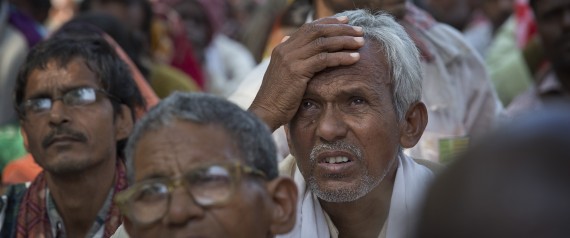The suicide of a farmer at the AAP rally today in the heart of Delhi is a stark symbol of rural anger and helplessness. It is an equally grim reminder that political parties have no solution to offer other than a relentless barrage of sound bites and photo opportunities at the hospital.
Urban India’s interest in agriculture begins and ends with the annual monsoon forecast and the weekly inflation number. In 2014-15, the monsoon was normal and inflation was subdued. In other words, there was no impending rise in food prices. So all eyes were off the ball.India’s 118 million farmers experienced 2014-15 differently. They were saddled with more production than the market could absorb–due to the overhang of last year’s stocks and dull exports, and high fixed costs. And they lack the financial resilience to cope with this situation. Indian agriculture is financed by debt. If farmers don’t at least break even in a year, they can’t pay back banks, village moneylenders, commission agents, and agri-input dealers. School fees, motorcycle loan, tractor loan and other recurring costs become a noose.This year, there was hardly any money on the table throughout the food value chain because of the depressed prices. Sugarcane, traditionally the most profitable crop, is the classic example. Production has surpassed demand so comprehensively that prevailing wholesale prices are at round Rs22/kg while the cost of production of sugar (by crushing the cane in a mill) is Rs30. As a result, farmers have arrears of over Rs19,000 crore for sugarcane in 18 states, of which almost Rs10,000 crore is owed to farmers in Uttar Pradesh alone.There is little hope of succor any time soon as half of the 530 mills that were crushing cane this season have closed down to stem further losses. Since the average Indian farmer, with around one hectare of land, lacks the wherewithal to similarly hunker down, the human suffering is significantly larger than the financial suffering.
What Can Be Done To Help
Is there a way to ensure farmers acquire the financial strength to withstand a bad season or two? The answer does not lie in giving more crop loans or announcing loan waivers. Instead, farmers can be made more competitive by helping them reduce the cost of cultivation.Efforts to improve soil health can reduce the excessive spend on fertilizers and chemicals. Certified seed can ensure that no money is lost buying fakes trolling the market. There will be no need for expensive diesel gensets for tubewells if drip irrigation and better water management is promoted. Livestock and poultry act as a natural insurance against crop failure. But returns remain below par because high-yielding cross-bred animals are expensive.Small farmers save on labour and machinery costs by toiling themselves. The downside is the severe stress on health and wellness of the primary bread earner. The virtual absence of personal insurance and crop insurance makes it tough to recover from even a temporary setback because that requires ready cash in hand. Only 20% farmers in India have crop insurance. Substantially increasing this number will raise agriculture’s overall risk-bearing capability.
Post-harvest crop management and marketing are a serious addition to costs. From poor transportation systems and cartelization of middle men to the lack of modern warehousing and storage capacity, all inefficiencies in the system add to the farmer’s cost of business.The mobile phone alone can be of enormous help. A survey of farmers in Bihar, Punjab, Haryana, Uttar Pradesh, and West Bengal in 2011 found that more than 70% of the farmers polled said they were getting better prices because they were using the mobile phone for agricultural information.Lower cost of production will allow farmers to compete more strongly against China, Ukraine and Brazil in world commodity markets. This will take care of the problem of plenty that is often faced when India is outbid by these fierce competitors overseas. Most importantly, farmers have to build assets other than land. Gold remains the popular choice. But it is out of the reach of families without disposable income. If the crop itself becomes an asset in the hands of farmers through negotiable warehouse receipts, they will be freed from the vicious cycle of land mortages and foreclosures. Solutions to all these problems are available. The thrust to a national agri market, soil health cards, and Jan Dhan accounts by the Modi government is a good step. But the rest need an equally massive push because farmers themselves are too caught up in the relentless cycle of making two ends meet.The protests on the streets of Delhi are ultimately about the resilience of Indian agriculture to impending climate change. The freak weather incidents will become more frequent and years of normal monsoon rarer still. Traditional crop insurance will blow a fuse. How prepared is the Indian farmer to handle the impact of climate change on his economic life? That is the question. If our political parties are wise, they will spend some time pondering the issue.


You must be logged in to post a comment Login